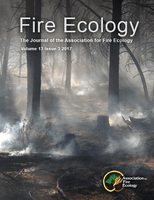
Fire Ecology
Scope & Guideline
Championing Research: Your Gateway to Fire's Ecological Secrets
Introduction
Aims and Scopes
- Fire Dynamics and Behavior:
Research on the physical and ecological processes of fire, including its behavior, spread, and interactions with various environmental factors. - Fire Management Practices:
Studies that assess the effectiveness and implications of various fire management strategies, including prescribed burning, fuel treatments, and community-based fire management. - Ecological Impact of Fire:
Investigations into how fire affects ecosystems, including plant and animal communities, soil properties, and landscape dynamics. - Socioeconomic Aspects of Fire:
Exploration of community perceptions, historical contexts, and the socio-political dimensions of fire management and ecology. - Technological Innovations in Fire Monitoring:
Development and application of new technologies, such as remote sensing and machine learning, for fire detection, analysis, and management. - Climate Change and Fire Regimes:
Research on the interactions between climate change and fire behavior, including changes in fire frequency, intensity, and ecological responses.
Trending and Emerging
- Community Engagement and Indigenous Knowledge:
There is a growing emphasis on incorporating community perceptions and Indigenous fire stewardship practices into fire management and ecological studies. - Technological Integration in Fire Management:
The use of advanced technologies, such as AI and remote sensing, for fire detection, monitoring, and management strategies is increasingly prevalent, reflecting a trend towards data-driven approaches. - Climate Change Impacts on Fire Regimes:
Research focusing on how climate change is altering fire dynamics, including frequency, intensity, and ecological consequences, is gaining traction as a critical area of study. - Resilience and Recovery Post-Fire:
Emerging studies are increasingly examining the resilience of ecosystems and communities following fire events, including recovery processes and long-term ecological impacts. - Fire's Role in Biodiversity and Ecosystem Services:
There is a rising interest in understanding how fire influences biodiversity and the provision of ecosystem services, highlighting fire's multifaceted ecological roles.
Declining or Waning
- Historical Fire Regime Studies:
Research focusing on the historical analysis of fire regimes has decreased, possibly due to a shift towards contemporary fire management practices and immediate ecological impacts. - Species-Specific Fire Adaptation Studies:
There has been a reduction in studies specifically addressing individual species' adaptations to fire, as the focus has broadened to include community-level responses and ecosystem dynamics. - Single-Factor Analysis:
Research concentrating on isolated factors influencing fire behavior or ecology has waned, with a growing emphasis on multi-factorial and integrated approaches. - Regional Case Studies:
While still relevant, the frequency of region-specific case studies has declined in favor of broader, comparative analyses that address global fire trends and management implications.
Similar Journals

Building Services Engineering Research & Technology
Advancing Sustainable Solutions in Building Services EngineeringBuilding Services Engineering Research & Technology is a leading journal published by SAGE Publications Ltd, dedicated to advancing the field of building services engineering. With an ISSN of 0143-6244 and an E-ISSN of 1477-0849, the journal has established itself as a vital resource since its inception in 1980, operating as an essential platform for disseminating high-quality research and technological innovations up to 2024. The journal is well-respected within the academic community, reflected in its Q2 category ranking in Building and Construction and a commendable 67th percentile rank among the 223 journals in its field, according to Scopus. Although it does not offer open access, it provides extensive insights and rigorous studies that are invaluable for researchers, practitioners, and students alike. As a central hub for the exploration of cutting-edge methods and principles in building services, the journal aims to foster a better understanding of sustainable and innovative practices within the industry.
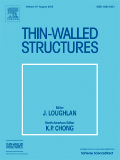
THIN-WALLED STRUCTURES
Innovating Design for Safer, Efficient StructuresTHIN-WALLED STRUCTURES is a premier international journal published by Elsevier Science Ltd, focusing on the critical areas of Building and Construction, Civil and Structural Engineering, and Mechanical Engineering. With an impressive impact factor and categorization in the Q1 quartile of each respective field, this journal stands at the forefront of engineering research, boasting commendable Scopus rankings—52nd for Mechanical Engineering, 18th for Building and Construction, and 32nd for Civil and Structural Engineering. Since its inception in 1983, THIN-WALLED STRUCTURES has provided a vital platform for disseminating innovative research, practical applications, and theoretical advancements in thin-walled structures, encouraging the development of safer and more efficient design methodologies. Although it operates on a traditional access model, the journal is committed to maintaining high-quality peer review and publishing, making it an essential resource for researchers, professionals, and students aiming to contribute to and benefit from the latest advancements in this dynamic field.

PROCEEDINGS OF THE LINNEAN SOCIETY OF NEW SOUTH WALES
Connecting Research with Conservation in Australia's Unique EcosystemsPROCEEDINGS OF THE LINNEAN SOCIETY OF NEW SOUTH WALES, ISSN 0370-047X, is a prestigious journal published by the Linnean Society of New South Wales, dedicated to the advancement of knowledge in the fields of natural history, ecology, and biodiversity. Established in the mid-20th century, this journal serves as a vital platform for reporting original research, reviews, and discussions on various aspects of Australian flora and fauna, along with broader contributions to environmental science. Though the journal is not open access, it remains an important resource for researchers, students, and professionals seeking to engage with high-quality studies that inform conservation efforts and ecological understanding in the region. The journal's historical significance is underscored by its coverage of pivotal research from 1980 to 2015, fostering ongoing dialogue within the scientific community and promoting the values of the Linnean Society's commitment to natural history scholarship.
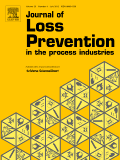
JOURNAL OF LOSS PREVENTION IN THE PROCESS INDUSTRIES
Enhancing operational excellence with interdisciplinary insights.The Journal of Loss Prevention in the Process Industries, published by Elsevier Science Ltd, stands as a vital platform for advancing knowledge and practice in risk management and safety within the fields of chemical engineering, industrial and manufacturing engineering, and beyond. With an H-Index reflecting significant scholarly influence, this journal features a diverse scope, addressing critical issues from process safety and reliability to innovative solutions for energy efficiency. Ranking in the second quartile (Q2) across several categories, including Control and Systems Engineering and Safety, Risk, Reliability and Quality, it highlights the interdisciplinary nature of loss prevention strategies. Researchers and professionals can access this journal through subscription, ensuring they stay at the forefront of developments from 1988 to 2024. As a hub of cutting-edge research, the journal not only aims to disseminate high-quality studies but also fosters a community dedicated to enhancing safety and operational excellence in process industries worldwide.
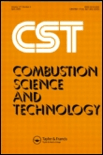
COMBUSTION SCIENCE AND TECHNOLOGY
Bridging Disciplines in Combustion TechnologyCOMBUSTION SCIENCE AND TECHNOLOGY, published by Taylor & Francis Inc, is a pivotal journal in the fields of Chemical Engineering and Chemistry, with a robust history spanning from 1969 to 2024. With an established impact factor and a strong reputation reflected in its Q2 ranking in both Chemical Engineering and Chemistry, this journal serves as an essential resource for researchers and professionals dedicated to the intricacies of combustion processes and energy technologies. The journal also holds commendable rankings in Energy Engineering, Fuel Technology, and Physics and Astronomy, showcasing its interdisciplinary relevance. While currently not an open-access publication, it offers a wealth of knowledge through its meticulously peer-reviewed articles, which are crucial for advancing understanding and innovation in combustion science. With a commitment to promoting rigorous research and fostering scholarly communication, COMBUSTION SCIENCE AND TECHNOLOGY is indispensable for anyone seeking cutting-edge insights into combustion phenomena and their applications in various engineering fields.
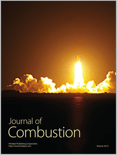
Journal of Combustion
Leading the Way in Combustion StudiesJournal of Combustion is a premier academic journal dedicated to the field of combustion science and technology, published by HINDAWI LTD. With an ISSN of 2090-1968 and an E-ISSN of 2090-1976, the journal has been an open-access platform since 2008, ensuring that cutting-edge research is accessible to all. Based in the United States at Adam House, 3rd Flr, 1 Fitzroy Sq, London W1T 5HF, England, the journal publishes articles spanning various relevant disciplines, contributing to knowledge in Chemical Engineering, Fuel Technology, and Energy Engineering. As of 2023, it ranks in the Q3 quartile in Chemical Engineering (miscellaneous) and Fuel Technology, and in Q4 in Condensed Matter Physics and Energy Engineering and Power Technology, highlighting its growing impact and relevance in these fields. Researchers will find valuable insights as the journal converges its findings from 2010 to 2024. With a focus on promoting innovative approaches and exploring new frontiers in combustion research, the Journal of Combustion continues to be an essential resource for academics, professionals, and students committed to advancing the understanding and application of combustion processes.

Journal of Structural Fire Engineering
Empowering engineers to combat fire hazards effectively.The Journal of Structural Fire Engineering is a premier academic publication dedicated to advancing the field of fire safety and structural engineering. Published by Emerald Group Publishing Ltd, this journal features high-quality research and innovative solutions addressing crucial aspects of safety, risk, reliability, and the mechanics of materials. With an impact factor that reflects its growing influence in the academic community and a classification in the Q3 quartile across several engineering categories, the journal plays a vital role in disseminating knowledge that bridges theoretical concepts and practical applications. With coverage spanning from 2010 to 2024, researchers, professionals, and students can access a wealth of studies that explore the intersection of structural integrity and fire safety. While it currently operates under a subscription model, the journal remains committed to sharing pivotal insights that drive forward the discipline. Join the community of experts striving to enhance engineering practices and resilience against fire-related hazards.

INTERNATIONAL POLYMER PROCESSING
Navigating the Complexities of Polymer ProcessingINTERNATIONAL POLYMER PROCESSING, published by WALTER DE GRUYTER GMBH, serves as a crucial platform for professionals and researchers in the fields of Chemical Engineering, Industrial and Manufacturing Engineering, and Materials Science, particularly focusing on polymers and plastics. With its ISSN 0930-777X and E-ISSN 2195-8602, this journal has been in circulation since 1988 and continues to expand its contributions to contemporary research trends through to 2024. Ranking in the third quartile across multiple categories, including Chemical Engineering (miscellaneous) and Materials Chemistry, it offers insightful and rigorous peer-reviewed articles that enhance the understanding of polymer processing technologies and innovations. This journal is vital for anyone engaged in polymer science and engineering, providing both theoretical and practical perspectives that advance the field. Although it does not provide open access, the journal's content is indispensable for academia and industry professionals looking to stay at the forefront of polymer research.
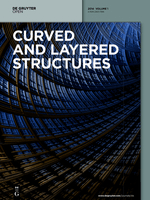
Curved and Layered Structures
Pioneering Research in Structural ComplexityCurved and Layered Structures, published by DE GRUYTER POLAND SP Z O O, is a distinguished open-access journal that has been an essential platform since 2014 for academics and professionals in the fields of Aerospace Engineering, Architecture, Building and Construction, Civil and Structural Engineering, and Computational Mechanics. With an ISSN of 2353-7396, it is recognized for its impactful contributions, reflected in its impressive category quartiles, particularly Q1 in Architecture and notable rankings in various engineering disciplines. The journal's scope encompasses innovative research focusing on the intricate designs and applications of curved and layered structures, making it pivotal for advancing knowledge in these areas. The open-access format ensures widespread dissemination of research findings, promoting accessibility and collaboration among researchers and practitioners worldwide. As it navigates its converged years from 2014 to 2024, Curved and Layered Structures continues to attract high-quality submissions that push the boundaries of engineering and architectural design.

Lesnoy Zhurnal-Forestry Journal
Advancing Sustainable Forestry for a Greener TomorrowLesnoy Zhurnal-Forestry Journal is a prominent academic publication dedicated to advancing the field of forestry and environmental sciences. Published by the Northern Arctic Federal University M. V. Lomonosov, this journal focuses on innovative research, practices, and policies related to forestry management and conservation. With an Open Access model established since 2015, the journal ensures widespread dissemination of knowledge and foster collaborative research across global scholarly communities. Located in Arkhangelsk, Russia, the Lesnoy Zhurnal appeals to researchers, professionals, and students alike, providing a platform for sharing valuable insights and addressing emerging challenges in forestry. Though specific metrics like HIndex and Scopus rankings are presently unlisted, the journal is committed to excellence and aims to enhance its visibility and impact within the scientific community. This publication is not only a critical resource for ongoing research but a key player in shaping sustainable forestry practices in a rapidly changing environment, making it indispensable for anyone involved in forestry and environmental studies.